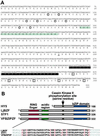A Lotus basic leucine zipper protein with a RING-finger motif negatively regulates the developmental program of nodulation
- PMID: 12397181
- PMCID: PMC137568
- DOI: 10.1073/pnas.222302699
A Lotus basic leucine zipper protein with a RING-finger motif negatively regulates the developmental program of nodulation
Abstract
The developmental program of nodulation is regulated systemically in leguminous host species. A mutant astray (Ljsym77) in Lotus japonicus has lost some sort of its ability to regulate this symtem, and shows enhanced and early nodulation. In the absence of rhizobia, this mutant exhibits characteristics associated with defects in light and gravity responses. These nonsymbiotic phenotypes of astray are very similar to those observed in photomorphogenic Arabidopsis mutant hy5. Based on this evidence, we predicted that astray might contain a mutation in the HY5 homologue of L. japonicus. The homologue, named LjBzf, encodes a basic leucine zipper protein in the C-terminal half that shows the highest level of identity with HY5 of all Arabidopsis proteins. It also encodes legume-characteristic combination of motifs, including a RING-finger motif and an acidic region in the N-terminal half. The astray phenotypes were cosegregated with LjBzf, and the failure to splice the intron was detected. Nonsymbiotic and symbiotic phenotypes of astray were complemented by introduction of CaMV35SLjBzf. It is noteworthy that although Arabidopsis hy5 showed an enhancement of lateral root initiation, Lotus astray showed an enhancement of nodule initiation but not of lateral root initiation. Legume-characteristic combination of motifs of ASTRAY may play specific roles in the regulation of nodule development.
Figures





Comment in
-
Shedding light on an underground problem.Proc Natl Acad Sci U S A. 2002 Nov 12;99(23):14616-8. doi: 10.1073/pnas.242594599. Epub 2002 Nov 4. Proc Natl Acad Sci U S A. 2002. PMID: 12417751 Free PMC article. No abstract available.
Similar articles
-
The Arabidopsis HY5 gene encodes a bZIP protein that regulates stimulus-induced development of root and hypocotyl.Genes Dev. 1997 Nov 15;11(22):2983-95. doi: 10.1101/gad.11.22.2983. Genes Dev. 1997. PMID: 9367981 Free PMC article.
-
Knockdown of LjALD1, AGD2-like defense response protein 1, influences plant growth and nodulation in Lotus japonicus.J Integr Plant Biol. 2014 Nov;56(11):1034-41. doi: 10.1111/jipb.12211. Epub 2014 Jun 19. J Integr Plant Biol. 2014. PMID: 24797909
-
Endoreduplication-mediated initiation of symbiotic organ development in Lotus japonicus.Development. 2014 Jun;141(12):2441-5. doi: 10.1242/dev.107946. Epub 2014 May 21. Development. 2014. PMID: 24850853
-
Leguminous plants: inventors of root nodules to accommodate symbiotic bacteria.Int Rev Cell Mol Biol. 2015;316:111-58. doi: 10.1016/bs.ircmb.2015.01.004. Epub 2015 Feb 20. Int Rev Cell Mol Biol. 2015. PMID: 25805123 Review.
-
Emerging functions of mammalian and plant mTERFs.Biochim Biophys Acta. 2015 Sep;1847(9):786-97. doi: 10.1016/j.bbabio.2014.12.009. Epub 2015 Jan 10. Biochim Biophys Acta. 2015. PMID: 25582570 Review.
Cited by
-
Rapid phosphoproteomic and transcriptomic changes in the rhizobia-legume symbiosis.Mol Cell Proteomics. 2012 Sep;11(9):724-44. doi: 10.1074/mcp.M112.019208. Epub 2012 Jun 8. Mol Cell Proteomics. 2012. PMID: 22683509 Free PMC article.
-
Genome-wide identification and evolutionary analysis of TGA transcription factors in soybean.Sci Rep. 2019 Aug 1;9(1):11186. doi: 10.1038/s41598-019-47316-z. Sci Rep. 2019. PMID: 31371739 Free PMC article.
-
Cysteine-Rich Receptor-Like Kinase Gene Family Identification in the Phaseolus Genome and Comparative Analysis of Their Expression Profiles Specific to Mycorrhizal and Rhizobial Symbiosis.Genes (Basel). 2019 Jan 17;10(1):59. doi: 10.3390/genes10010059. Genes (Basel). 2019. PMID: 30658517 Free PMC article.
-
Long-distance transport of signals during symbiosis: are nodule formation and mycorrhization autoregulated in a similar way?Plant Signal Behav. 2011 Mar;6(3):372-7. doi: 10.4161/psb.6.3.13881. Epub 2011 Mar 1. Plant Signal Behav. 2011. PMID: 21455020 Free PMC article. Review.
-
crinkle, a novel symbiotic mutant that affects the infection thread growth and alters the root hair, trichome, and seed development in Lotus japonicus.Plant Physiol. 2003 Mar;131(3):1054-63. doi: 10.1104/pp.102.017020. Plant Physiol. 2003. PMID: 12644658 Free PMC article.
References
-
- Jacobsen E. & Feenstra, Q. J. (1984) Plant Sci. Lett. 33, 337-344.
-
- Duc G. & Messager, A. (1989) Plant Sci. 60, 207-213.
-
- Sagan M., Morandi, D., Tarenghi, E. & Duc, G. (1995) Plant Sci. 111, 63-71.
Publication types
MeSH terms
Substances
Associated data
- Actions
- Actions
- Actions
LinkOut - more resources
Full Text Sources
Molecular Biology Databases

